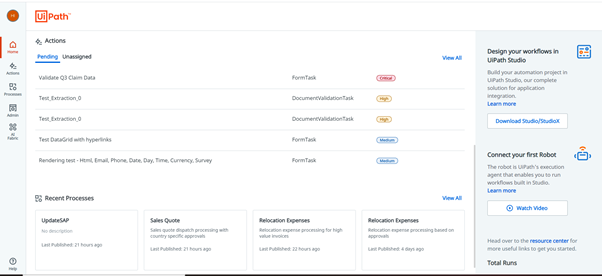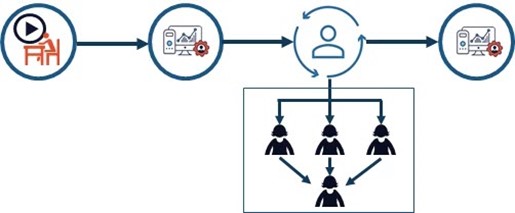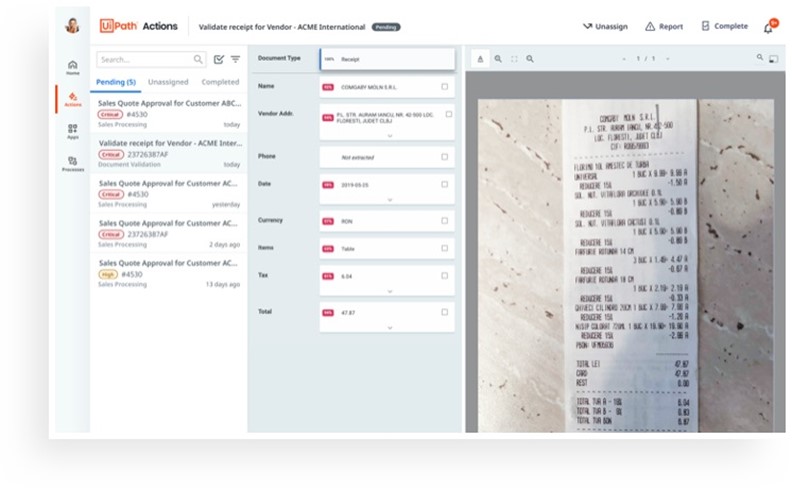
In a recent Deloitte study , 32% of all CEOs cite silos and fragmentation as the biggest obstacle to scaling automation. A new product from UiPath - Action Center, helps to bring everything together and manage automation from a centralized interface. In addition, the solution allows you to connect employees to automated processes, the result of which requires human verification; and then returns the process to completion to the appropriate free robots.
UiPath Action Center is a single interface where users can see all their tasks and documents, and take the necessary actions. Now you don't need to look through hundreds of emails - all information and management in one place. And if the user is already using some external tools, then through the API they can be linked together.

UiPath Action Center is a hub for convenient transfer of processes from a person to a robot, and vice versa.
Automation of business processes to increase economic efficiency
Processes that span all business units and require robot-to-human handover can provide great ROI, but can be difficult to automate from start to finish.
Action Center empowers business users to handle workflows and provide business resources to robots. It provides support for long, automated workflows that require human intervention, since the entire process is fragmented and can be paused and resumed after a human evaluates intermediate results.

The structure of a fragmented process with its transmission to a person for its intermediate assessment.

Convenient interface for human-robot interaction
Cooperation between robots and humans
Using drag-and-drop, it is easy to create robots that control the process of platform-human interaction. Putting people in the loop using the capabilities of the UiPath Action Center helps automate end-to-end business processes. Humans and robots can now collaborate. For example, a robot processes an invoice, a person fills in fields that could not be recognized, and then the robot sends the result to the SAP application.
Video "Automating Invoice Processing with UiPath Action Center"
One click automation
Automation can now be triggered by filling out custom forms and uploading files to Action Center. There is no need to enter UiPath Orchestrator or think about what solutions are “under the hood”, all processes are available on the Processes tab. You are always aware of the status and results of automation.
Monitoring complex workflows
You can track complex workflows across business units, tasks, people, and robots from one central portal. Identify bottlenecks and inefficiencies to speed up the flow of workflows and get a full audit of the categories you need.

UiPath Action Center interface with complex workflows
Third party integrations
If you already use external tools such as business process management software, then you can use our APIs to connect processes to Action Center. Integration with the UiPath verification station makes it easy to manage documents, and all processes remain under control when integrated with UiPath Process Mining.
UiPath Document Understanding uses RPA and AI to help extract and interpret data from a variety of documents and enable end-to-end document processing. The tool is able to work with various documents from structured to unstructured, recognizes various objects such as tables, handwritten text and signatures. Using machine learning algorithms, you can work with unstructured documents. Together with RPA, AI helps automate a wide range of complex tasks that previously required manual processing.

Integration with third-party systems: structured document recognition
A guide with examples of RPA processes
An end-to-end workflow that requires user validation is configured in UiPath Studio using a template and custom out-of-the-box activities. This RPA process generates tasks to be performed by users in Automation Cloud. After the user has completed the task, the result is sent back to the process and executed by the available UiPath robot. In the context of long-term business processes, this allows for better resource allocation and reduced downtime: task fragments can be performed by any free robot.
An example of a workflow illustrating the transfer of a process to a person depending on the type of document.
Example a workflow that demonstrates all supported form controls.
UiPath Apps is a convenient addition to Action Center
Action Center allows users to process tasks coming from robots, but if you need to create an application with a convenient interface for controlling robots, that is, the low-code UiPath Apps platform.
UiPath Apps delivers a dynamic experience, and with RPA tools, it can be packaged into an intuitive and user-friendly interface. Low-code environment and the ability to transfer ready-made elements to the development environment allow you to turn business ideas into convenient applications. In this way, employees of the company can get direct access to automation and use it to solve work tasks. UiPath Apps is a great addition to the UiPath Action Center, popularizing and significantly lowering the threshold for widespread use of RPA in business.
What's the bottom line?
The Action Center release played a key role in expanding the range of business processes that can be automated with RPA. Ready-to-use integrations with AI-based UiPath solutions and process mining provide ample opportunities to automate processes using the Action Center and a seamless transition from human to robot.
Action Center is now available not only for enterprise versions of the platform, but also for users of the cloud solution. To get free access to Action Center, you need to use Automation Cloud. UiPath is constantly working on updates to the Action Center and will be adding a number of business-friendly features in the near future.